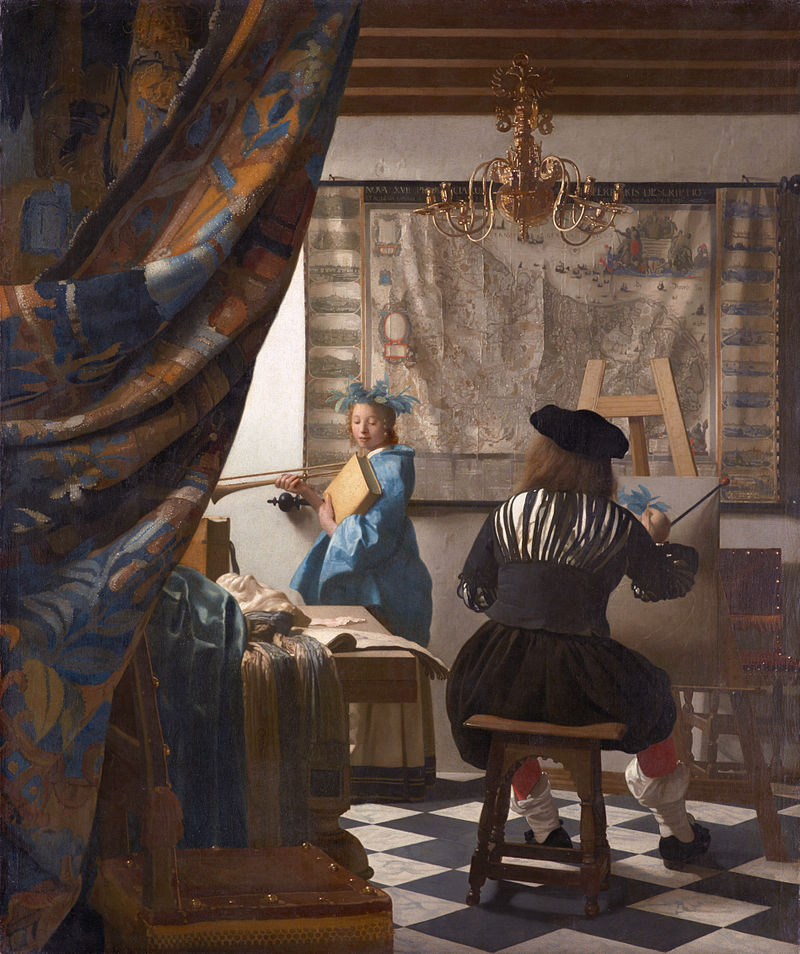People
6 Curious Facts About Vermeer in Celebration of His 384th Birthday
"The Sphinx of Delft" was a largely unknown artist until the late 19th century.
"The Sphinx of Delft" was a largely unknown artist until the late 19th century.
Caroline Elbaor

Dutch Master Johannes Vermeer was baptized on this day in 1632 in his hometown of Delft in the Netherlands. For centuries, the painter was a mysterious figure in art history, with very little known about his personal life, thus earning him the nickname “The Sphinx of Delft.”
Here, we’ve sleuthed around and gathered up six facts about Vermeer to shed more light on the once overlooked painter.

Girl with a Pearl Earring (circa 1665). Courtesy Wikimedia commons.
1. His artistic achievements went largely unnoticed throughout his life and in the centuries that followed.
Though Vermeer now holds his place in history books as one of the greatest painters of the Dutch Golden Age, he wasn’t always so admired. Until the 19th century, he enjoyed little-to-no success as an artist, and many of his pieces were credited as the work of other Dutch artists, including Metsu and Mieris.
It was only after the publication of Théophile Thoré-Bürger’s catalogue raisonné of Vermeer’s works in 1866—resulting in rapid attention and exposure—that his work gained renown for its lifelike depictions of middle-class life, set in photo-realistic interiors of homes.

The Concert (circa 1663–1666). Courtesy Wikimedia commons.
2. The Dutch Master had no formal training, suggesting he was self-taught.
Because evidence and details surrounding his life are still minimal, where and under whom—if anybody—Vermeer apprenticed remains a mystery. Naturally, theories about his influences abound, but the general consensus, first posited by American art historian Walter Liedtke, is that Vermeer was a self-taught man.

The Astronomer (1668). Courtesy Wikimedia commons.
3. There are only 36 authenticated paintings by Vermeer in the world.
Vermeer was an intensely methodical painter, working carefully and with great attention to detail. Therefore, the artist’s output was limited; at present, he only has 36 canvases to his name.
Moreover, Vermeer signed none of his works, and he dated only three (The Procuress, 1656; The Geographer, 1668–1669; and The Astronomer, 1668), thus challenging scholars who attempt to authenticate a work. To add to the confusion, experts are reluctant to declare a painting a Vermeer due to his far-reaching influence on other painters, as well as the threat of fakes.

A Maid Asleep (circa 1656–1657). Courtesy Wikimedia commons.
4. In the late 1930s and early ’40s, a copycat artist forged and sold works he marketed as newly discovered Vermeers.
From 1938 to 1945, Han van Meegeren created paintings he passed off as original Vermeers, fooling experts and collectors alike, in a move that earned him what would be roughly $30 million today.
It was only after World War II that a strange turn of events revealed van Meegeren’s forgeries. Having sold a painting to the prominent Nazi deputy Hermann Goering, van Meegeren defended himself against accusations of collaborating with the Nazis by revealing that he had dealt Goering a fake. As such, van Meegeren then proceeded to call himself a hero for having “hoodwinked” the enemy. He was nevertheless convicted of fraud and sentenced to a year in prison.

Love Letter (circa 1669–1670). Courtesy Wikimedia commons.
5. In 1971, Vermeer’s Love Letter was stolen from the Fine Arts Palace in Brussels in an ill-devised heist.
On September 23, 1971, a twenty-one-year-old man named Mario Roymans broke into the Fine Arts Palace in Brussels and stole Love Letter, which was on loan from Amsterdam’s Rijksmuseum as part of the Rembrandt and his Age exhibition.
The painting was severely damaged due to the thief’s recklessness during the two weeks in which it was missing. When Roymans discovered that Love Letter was too big to fit through the window he planned to abscond through, he removed it from the frame with a potato peeler and stuffed the canvas in his back pocket. He later buried it in the forest where it sustained water damage, and hid it under his mattress, where it was crushed.
After Love Letter was recovered, an international committee of Vermeer experts was convened to restore the painting.

Artist in His Studio (circa 1666–1668). Courtesy Wikimedia commons.
6. Despite his chosen career, Vermeer nevertheless questioned the role and impact of painting, as is seen in the work Artist in His Studio.
Artist in His Studio, also known as The Allegory of Painting or Painter in his Studio, is one of Vermeer’s most famous—and widely scrutinized—pieces, and it suggests that Vermeer examined the role of painting through his own work, perhaps while also seeking fame.
The woman portrayed is thought to be symbolic of either the Greek goddess Pheme, the spiritual personification of fame, or Clio, the muse of history. (This is evidenced by her laurel wreath, trumpet, and the book she holds.) The map on the far wall further underscores the theme of history present in the painting. Since the man shown is thought to be a self-portrait, one can deduce that Vermeer was arguing for painting’s role as a respected artistic endeavor, and that he meditated not only on painting’s place—but also his own—in history.